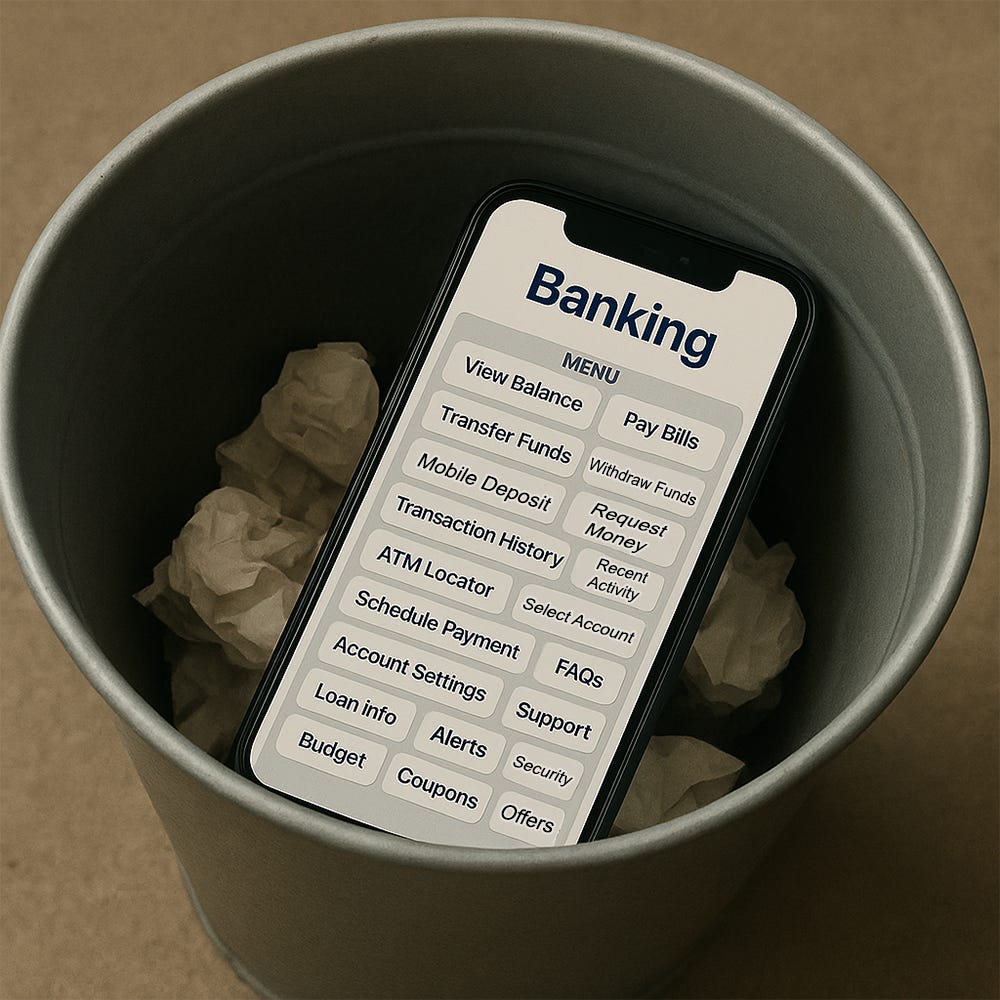The End of the UI as We Know It
Why Agentic AI Means Never Picking the Right Account Again
Not long ago, perfecting your user interface (UI) was everything. Providing consumers with the cleanest dashboard, the most intuitive navigation, and the most delightful color scheme was the angst of product managers. As automated technologies continue to advance however, that era is at a crossroads. The reason? Agentic AI and large language models (LLMs) are quietly—and sometimes loudly—making UIs less critical.
The New Way: Typing your Thoughts
Imagine this common scenario: you want to move some money from one of your bank accounts to another. You open your banking app, tap around through all the different options, find the account center, and eventually access your “Checking” account. You hit transfer, you choose “Savings,” you type in the amount, you click confirm, etc. The entire process is built around you, the human, navigating a UI maze of menus, checkboxes, and security measures to make a simple transfer.
Now, let’s try it using agentic AI.
You simply type: “Move $500 from my main checking account to savings, and make sure it’s done by the end of today.”
Or even simpler: “Transfer $500 to savings.”
The system, knowing your intent, your preferences, and—critically—who you are, does it all. No clicking, no hunting around, no “which account was that again?” The agent handles context, routing, and verification for you, turning the LLM into your own personal UI.
The Rise of the Invisible Interface
At Frontier Foundry, we are working to incorporate agentic AI into organizations across a multitude of industries. Our clients have already seen the value of these systems, and when combined with the power of LLMs, such as our proprietary model, Limni, these tools have the potential to change how humans interact with digital platforms and services altogether.
What’s happening is more than just adding a chatbot to your app. We’re moving from graphical user interfaces (GUIs) to no interface at all. The LLM, armed with context about you (your past transactions, preferences, identity), resolves ambiguity automatically. You no longer wade through a sea of options to “choose the right account.” You just say what you need, and your personalized AI will take care of the rest, understanding your needs from a few simple sentences.
The convenience LLM-based interfaces offer provides value across all aspects of organizations. Externally, they allow for better accessibility of their platforms for clients, making it easier to access the services they need. Externally, it can automate tasks and reduce workloads for employees, allowing them to focus on larger scale projects.
A few years ago, UIs were key to navigating every process. Today, AI is the map and the territory, used to both initiate and complete tasks. The very notion of clicking through tabs and drop-downs is starting to feel outdated, as more organizations move towards LLM interface systems due to the accessibility and ease-of-use it offers.
The Implications: Smarter, Faster, Less Friction
As agentic AI gets better, the value of traditional UI gets lower.
Cognitive Offloading: Why memorize the steps for an expense reimbursement when you can tell an LLM, “Reimburse me for last week’s client lunch,” and enable an AI agent to pull up the right account, match the receipt, and file it for you?
Hyper-Personalization: No more “one size fits all” navigation. Your agent learns you—your workflows, your quirks, your goals—to efficiently meet your needs.
Seamless Identification: You don’t pick “Roque Martinez’s account.” The AI knows it’s you and acts accordingly, managing tasks across all your services.
From “User” to “Command Giver”
For product designers and developers, this is both exhilarating and terrifying. The game isn’t about buttons and sliders anymore—it’s about analyzing context, understanding intent, and safe execution. The winners will be those who build the best agents, not the prettiest interfaces.
Of course, UIs won’t vanish overnight. There will always be a place for beautiful visualizations and human-in-the-loop checkpoints. But the days of users needing to “choose the right account” are numbered.
Next time you’re about to design a new app, ask yourself: are you building for clickers, or for commanders?
This article was written by Roque Martinez, CTO of Frontier Foundry. Visit his LinkedIn here.
To stay up to date with our work, visit our website, or follow us on LinkedIn, X, and Bluesky. To learn more about the services we offer, please visit our product page.



